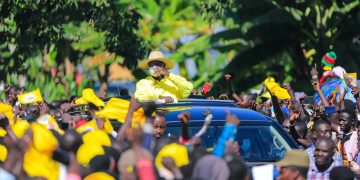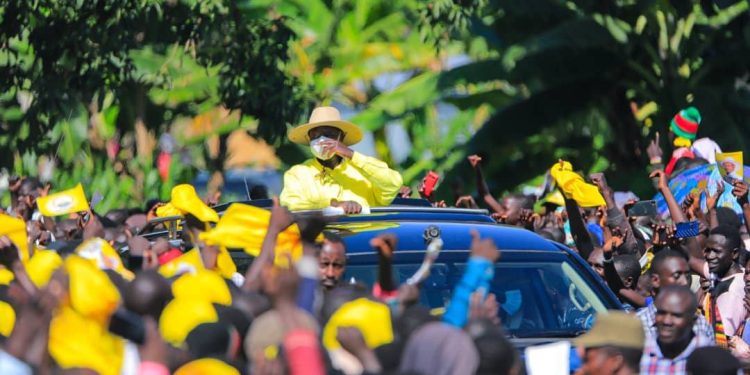Omoro — President Yoweri Kaguta Museveni has announced that the government will give special consideration to the Acholi sub-region under the new format of the Cattle Compensation Program, which is set to be rolled out across Acholi, Lango, and Teso.
The program seeks to redress the historical loss of livestock and wealth suffered by families during the insurgencies that devastated Northern Uganda for decades.
Addressing thousands of supporters during a campaign rally at Opit Primary School playgrounds in Omoro Town Council, President Museveni, who is also the NRM Presidential Flag Bearer, said the government had reviewed the previous compensation framework and adopted a fairer, more transparent, and inclusive model that ensures all affected households are reached.
“When the Acholi delegation came, they said Acholi suffered the longest and most severe period during the insurgencies. Therefore, beyond the five cows per household, we must also handle genuine claimants who lost a lot,” President Museveni said.
“I am glad we have agreed on a minimum of five cows for all affected households, and Cabinet will also study the idea of a variation specifically for the Acholi area,” he added.
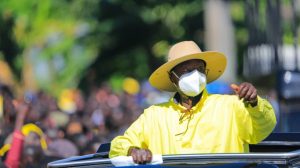
The President revealed that while the government had previously spent Shs. 159 billion on compensation across the three regions, the process had been marred by irregularities and lack of transparency.
“I started checking and found that a lot of money was being misused. The majority of genuine homesteads were left out,” he said.
Following consultations with leaders from Teso, Lango, and Acholi, the government resolved that each homestead will receive five cows under a harmonised and equitable distribution model.
According to official data, 4,836 claimants in Acholi have already been compensated, including 583 from Omoro District, who collectively received Shs. 5.6 billion.
NRM’s Record of Peace and Development
President Museveni used the rally to reaffirm the NRM’s legacy of peace, stability, and national unity, describing these as the foundation for Uganda’s transformation.
“For the first time in our history, the NRM has maintained peace across Uganda. That peace is what has allowed development to thrive,” he said.
He outlined two key pillars of the NRM’s achievements: peace and development. Under development, he highlighted massive investments in economic infrastructure—roads, electricity, telecommunication, and water systems—and social infrastructure such as schools and health facilities.
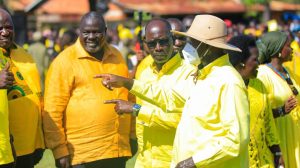
“We have tarmacked roads in Acholi in three directions — Karuma–Pakwach, Karuma–Gulu–Nimule, and Olwiyo–Gulu–Kitgum–Musingo,” he said. “We are also going to construct the Gulu–Awere–Kona Kilak road and the Kitgum–Palabek–Atiak road.”
The President further reflected on Uganda’s oil discovery, attributing it to NRM leadership and divine timing.
“The British were here for 68 years and gave up in 1956 despite signs of petroleum. When we came, we discovered it, and next year, oil will begin to flow,” he said. “Once oil revenues come in, these roads and other projects will be even easier to implement.”
Progress in Education and Health
President Museveni expressed satisfaction with the progress made in education and health infrastructure in Omoro District.
“In 1961, there were only six schools in the country offering A-level. Today, Omoro alone has eight secondary schools with A-Level. This is real progress,” he said.
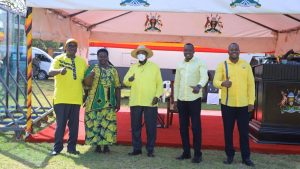
Omoro District now boasts 67 government primary schools, 81 private primary schools, 8 government secondary schools, and 11 private secondary schools. A new government secondary school in Lakwana Sub-County has further reduced the number of sub-counties without a secondary school from eight to seven.
However, the President emphasised that infrastructure alone does not guarantee prosperity. “You don’t sleep on the tarmac road; you sleep in your home. True progress means having wealth in your household,” he said.
Wealth Creation and the Parish Development Model
President Museveni reiterated that development without household wealth leads to dependency. He traced Uganda’s economic empowerment journey through Entandikwa, NAADS, Operation Wealth Creation (OWC), Emyooga, and now the Parish Development Model (PDM).
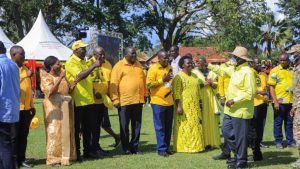
He cited the story of Anena, a PDM beneficiary from Omoro who used her Shs. 1 million seed capital to plant groundnuts, harvesting 35 bags worth over Shs. 2 million.
“She bought goats, a sewing machine, and now earns a daily income. This program is not for rich people like Museveni or Otema; it is for beginners who want to lift themselves,” he said.
President Museveni also announced that government will increase funding to local leaders under PDM from Shs. 100 million to Shs. 115 million per parish and create a special fund for religious and cultural leaders.
He warned against corruption in the program, stressing that government will closely monitor all disbursements.
According to official figures, Omoro District’s 65 parishes have received Shs. 19.96 billion in PDM funds, with 99.77% disbursed to 19,920 beneficiary households.
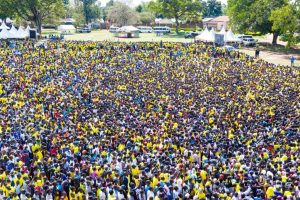
Additionally, the district’s two constituencies have 28 Emyooga SACCOs with 7,993 members, who have collectively received Shs. 1.3 billion, alongside member savings of Shs. 48.7 million.
Vocational Training and Job Creation
President Museveni underscored the importance of vocational skills as a sustainable path to job creation, citing graduates from the Gulu Industrial Skilling Hub who are now self-employed.
“These young people are producing shoes and metal products that we used to import. This is why, in the next government, we must stop charging school fees in public schools,” he said.
He condemned the commercialization of education and pledged to recruit more teachers while prioritizing investments in classrooms, laboratories, and teachers’ houses.
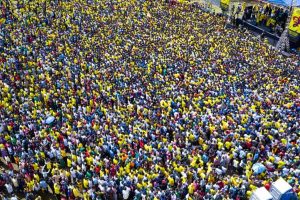
“Government jobs employ only 480,000 people out of 46 million Ugandans. Real jobs come from commercial agriculture, artisanship, and industrialisation,” he said.
As an example, he cited Hon. Fred Byamukama, Minister of State for Transport, who practices the four-acre model—growing coffee, bananas, fruits, and poultry, earning Shs. 55 million monthly and employing 26 people.
“That’s how wealth creation produces jobs,” the President said.
Leaders Commend NRM’s Achievements
Government Chief Whip and NRM Vice Chairperson for Northern Uganda, Hon. Denis Hamson Obua, praised President Museveni’s leadership for restoring peace and advancing development in Acholi.
“Your Excellency, the people of Omoro are here to thank you for peace, development, and wealth creation. Omoro is ready to lead in voting for you and all NRM flag bearers,” he said.
NRM Electoral Commission Chairperson Dr. Tanga Odoi, representing the party’s Secretary General, commended the people of Omoro for their large turnout, calling it one of the most impressive during the President’s northern Uganda campaign tour.
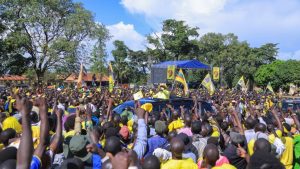
Omoro’s Voting Profile
According to the 2024 Census, Omoro District has 15 sub-counties/town councils, 65 parishes, and 458 villages, with a population of 207,339 people.
In the 2021 presidential election, the district had 72,216 registered voters, with a 51.2% turnout. President Museveni garnered 20,902 votes (60.7%), followed by NUP’s candidate with 7,169 votes (20.8%).
Ahead of the 2026 elections, the number of registered voters has increased to 86,550 across 220 polling stations, up from 158 in 2021 — a growth of 14,334 new voters.
President Museveni’s rally in Omoro marked his third campaign stop in the Acholi sub-region, as part of his ongoing northern Uganda campaign trail.
